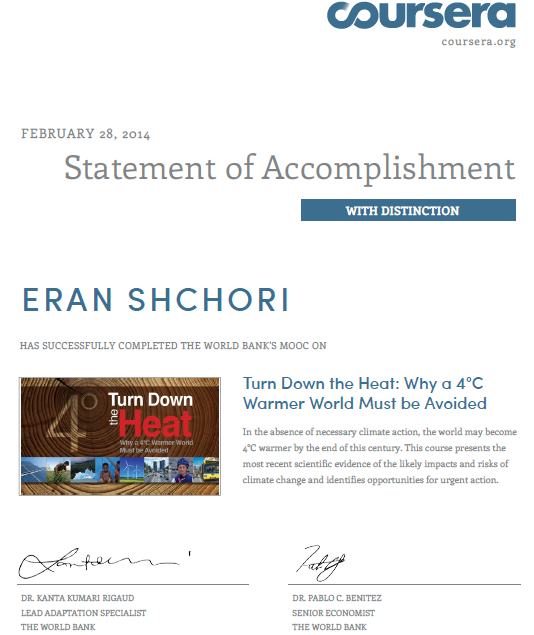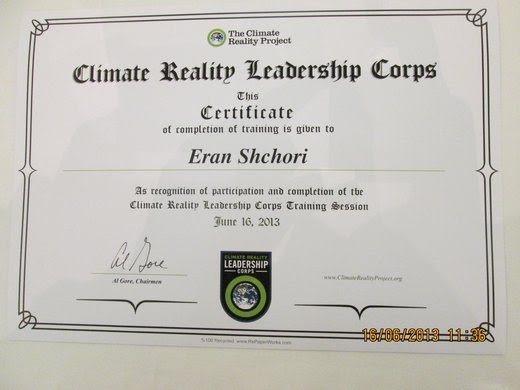


פעיל בארגון 'ריאליטי אקלים' (Climate Reality Project).
פורסם בתאריך: 01/03/2014
It is now clear that without action on climate change, the world may become 4°C warmer by the end of this century. Such an increase would threaten to roll back decades of development progress; thus, we are at a ‘make it or break it’ point in time. This course presents the most recent scientific evidence, as well as some of the opportunities for urgent action.
Under current pledges and commitments, the world is likely to reach 4°C degree warming by the end of the century and 2°C warming as early as 2040. This MOOC brings together renowned scientists to provide a synthesis of the most recent scientific evidence and presents an analysis of likely impacts and risks, with a focus on developing countries. It chronicles already observed changes in the climate system and their impacts, through the increase in carbon dioxide emissions, corresponding temperature increases and melting of glaciers and sea ice, and changes in precipitation patterns. This course also offers projections for the 21st century for droughts, heat waves and sea-level rise, with implications for food and water security, as well as possible impacts on agriculture, water availability, ecosystems and human health.
This MOOC presents an analysis of the likely impacts of a 4°C warming trajectory and stresses the need for decision makers and communities to take a serious look at their adaptation choices, while also signaling the urgency for mitigation action. Participants will also be introduced to the risks of triggering non-linearity, and tipping elements, such as the disintegration of the West Antarctic ice sheet and large-scale Amazon dieback. The course ends with a discussion of the main policy choices needed to prevent warming above 2°C.
Overview
This overview presents the main topics this course will cover, and provides a summary of the key impacts and challenges of a 4°C warmer world.
Week 1: Observed Climate Changes and Impacts: Hundreds of Thousands of Years to Now
This module outlines the historical observed changes in the climate system leading up to the present day and the impacts that can now be attributed to human-induced climate change. It examines the rise of greenhouse gas emissions since preindustrial times, while explaining the link between CO2 concentrations and the rising global mean temperature, ocean heat storage and sea-level rise, as well as uncertainties in the scientific evidence. It also describes the trends of increasing loss of ice in Greenland and Antarctica, increasing loss of Arctic sea ice, melting mountain glaciers, increased heat waves and extreme temperatures, and drought and aridity trends.
Week 2: Possible 21st Century Climates
This module provides an overview of the projected changes in climate leading up to the end of the 21st century. It describes the likelihood of a 4°C warmer world by 2100 AD and enables a deeper understanding of various climate models with different projections and key areas of uncertainty. It also reviews possible responses from natural systems, explaining how the projected climatic changes from 2°C to 4°C warming could result in sea-level rise, heat waves and extreme temperatures, and ocean acidification.
Week 3: Life in a 4°C Warmer World
a) Impacts Across Key Human Support Systems
This module presents an overview of current and projected climate impacts across key human support systems, such as agriculture and food production, water resources, ecosystems and biodiversity, and human health. Each of these human support systems will be negatively impacted by climate change under a 4°C warming scenario, resulting in adverse consequences for development, such as: diminishing crop yields, which threaten food production and human health; loss of biodiversity; the spread of vector-borne diseases; and water scarcity.
b) Risks of Large-Scale and Disruptive Changes in the Climate System
This module brings together information from earlier modules, by considering how the impacts of, risks from and vulnerabilities to climate change may scale with increasing levels of CO2 concentrations and global mean warming. It highlights the risks of nonlinear and cascading impacts and the risk of crossing critical thresholds for nonlinear tipping elements of the Earth system, which could dramatically increase vulnerability to climate change and impose multiple stresses on development.
Week 4: What Can We Do About It? The Choice Is in Your Hands (Discussion)
After having outlined the scientific evidence in previous modules, this final module goes beyond the Turn Down the Heat report and provides a discussion on what mitigation and adaptation action is needed to help avoid a 4°C world, while also decreasing vulnerability to climate change impacts and building climate resilience. Since no single solution exists, this module will share perspectives from a range of actors on a range of key policy measures and climate actions. Track 1 (for the general public) will showcase how different lifestyles may affect changes in the climate and explore everyday choices that can help mitigate climate change and decrease vulnerability to its impacts. Track 2 (for policymakers) invites leaders from various countries, the World Bank, the International Monetary Fund and civil society to exchange ideas and examples of effective policies and actions that can help in the transition towards a low-emissions and climate-resilient development path.
Depending on your particular interest, you can choose to participate in one of two tracks as an optional activity.
| Track 1 | Track 2 | |
| Target Audience | The ‘Climate Champions’ track is suitable for anyone with an interest in climate change, and provides more insight into the science behind climate change and opportunities to further expand your knowledge of key areas. | The ‘Policy and Leadership’ track involves connecting with others in similar positions (e.g., policymakers, provincial and national government personnel, representatives of civil society, academia) around the world, and developing new networks of practice around climate change issues. |
| Common objective | To understand observed changes in the climate system, their causes and immediate consequences, and projected medium- to long-term impacts on development | |
| Track-specific objectives | To describe the climate context under the current level of 0.8° warming and recognize how projected changes in climate (under 2°C to 4°C warming) could affect such sectors as agriculture, water resources, ecosystems and health To realize how your lifestyle contributes to changes in the climate system and outline the actions you can take to reduce your climate impact or carbon footprint | To critically interpret different climate projections and recognize how these changes in climate (under 2°C to 4°C warming as opposed to a current warming level of 0.8°C) could affect such sectors as agriculture, water resources, ecosystems and human health To discuss and distinguish between suitable policy options that countries/organizations need to take to help mitigate and adapt to climate change |
| Assignments |
|
|
Communicate and share resources via Twitter using hashtag #WBHeat.
| › | World Bank, 2012, Turn Down the Heat: Why a 4°C World Must Be Avoided |
› | World Bank, 2012, Turn Down the Heat: Why a 4°C World Must Be Avoided, Executive Summary in English, Spanish, French, German, Arabic or Portuguese |
› | World Bank, 2013, Turn Down the Heat: Climate Extremes, Regional Impacts, and the Case for Resilience |
› | Working Group I Contribution to the IPCC Fifth Assessment Report: Climate Change 2013: The Physical Science Basis, Summary for Policymakers |
This MOOC has a week-by-week structure, with resources, activities and exercises for you to engage in during each of the four weeks of the course. Each week, you will find a variety of course material, including:
If you successfully complete the course requirements, you will receive a Coursera Statement of Accomplishment. Course requirements include gaining a cumulative score of 50% in the following required activities: three quizzes, two peer review assignments and a final project. You will receive a distinction if you score 80% or over. These core resources and assignments will take around three hours per week to complete. More details will be provided after the course begins.
You can also go much further than this, engaging in optional exercises, networking, discussion forums and diving deeper into our rich selection of additional resources. We also will use e-discussions, Google Hangout and other tools to facilitate dialogue between the learners and experts.


שתפו ברשתות החברתיות:
קבל התראה מזדמנת לתיבת הדוא”ל